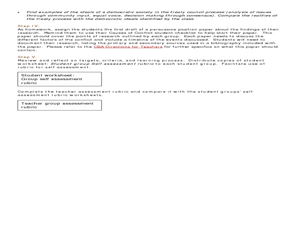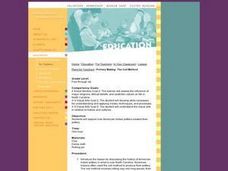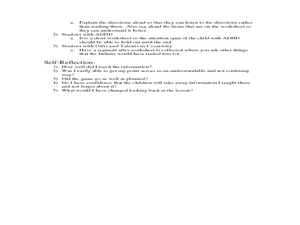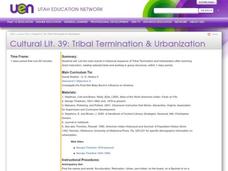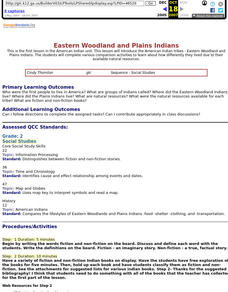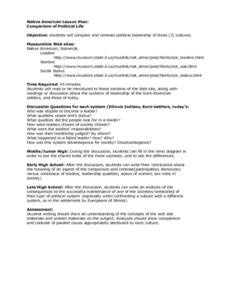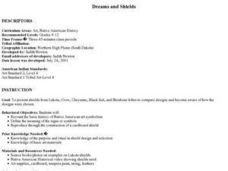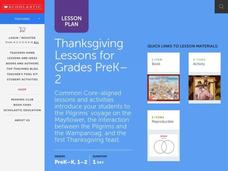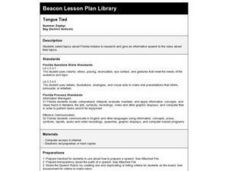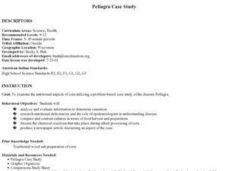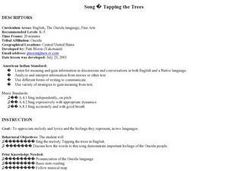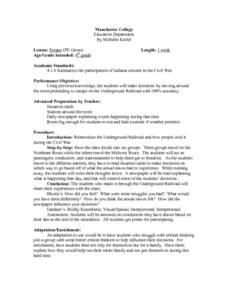Curated OER
Legends of the Navajo People
Second graders are read a story in which they begin to examine Native American legends. Using different legends, they discuss how they affected the future people of native peoples. They write a short story on the information they gathered.
Curated OER
Moon
Students discover scientific facts about the Moon and how
some American Indian Tribes used the moon to measure time.
They accomplish this by listening to stories and poetry, writing
stories, communicating with an astronaut,...
Curated OER
The Treaty Trail: US Indian Treaty Councils in the Northwest
Students research and examine primary sources concerning the Washington Territory. In this Native American removal lesson, students view portrait images created by Gustav Sohon. Students then read several biographies that correspond to...
Curated OER
Pottery Making: The Coil Method
Students discuss the history of Native American pottery in North Carolina. They explore the coil method of making pottery and make their own creations implementing the coil method. They can allow the pots to dry or have them kiln-fired.
Curated OER
Traditional Tribal Homelands of Washington's Plateau Nations
Students investigate the Plateau tribes. In this Native American lesson, students use a political map of Washington state to identify the location of the Plateau tribes. Students brainstorm the needs and wants of the tribes and use an...
Curated OER
La Salle and the Fur Trade
Fourth graders examine the fur trade of the 1700's. In this explorers lesson, 4th graders discuss how the French explorers traded items with the Native Americans for fur. They look at the explorer La Salle and how he influenced the fur...
Curated OER
Timeline In Indian Education
Students investigate the history of education for Native Americans. The roles of adults is the focus and how they delivered instruction to upcoming generations. Students focus upon the skill of oral tradition and write a summary of the...
Curated OER
Tribal Termination & Urbanization
Students are introduced to new vocabulary words associated with tribes and relocation. As a class, they listen to their teacher read an excerpt on tribal termination and urbanization. To end the lesson, they identify how this act...
Curated OER
Eastern Woodland and Plains Indians
Second graders are introduced to the American Indian tribes - Eastern Woodland and Plains Indians. They complete various comparison activities to explore how differently they lived.
Curated OER
I Heard the Owl Call My Name
Eleventh graders write a two to three page paper addressing one of the following topics: Analyze the values and beliefs of the two conflicting cultures. Explain which values seem to dominate within the conflict and why. They brainstorm...
Curated OER
South American Architecture
Seventh graders review and discuss what they read about North American architecture. They then study images of North and south American architecture and make comparisons
Curated OER
Comparison of Political Life
Young scholars research and compare and contrast the political leadership of three cultures.
Curated OER
Dreams and Shields
Students study and view examples of shields from the Lakota, Crow, Cheyenne, Black Feet, and Shoshone tribes. They find the meaning of the symbols used on the shields and then make their own shields out of cardboard.
Curated OER
Pocumtucks In Deerfield
Students read a story about the Pocumtucks' religious beliefs. Using the text, they discover their concept of land ownership and how they migrated within their territory in different seasons. They use primary and secondary sources to...
Scholastic
Thanksgiving Lessons Grades PreK-2
A quintessential resource for teaching an elementary unit on the first Thanksgiving addresses a variety of skills, including informational reading, critical thinking, comparing and contrasting facts, technology tools, and historical...
Curated OER
Creating a Pot: Repetition as a Unifying Design Element
Students use subjects, themes, and symbols that demonstrate knowledge of contexts, values, and aesthetics that communicate intended meaning in artworks.
Curated OER
Thirteen Moons Language Lesson
First graders study, discuss, and memorize the meanings in the Oneida Language of the most commonly used names for each of the Thirteen Moon cycles in their community. They draw pictures corresponding with the name of each of the moon...
Curated OER
Navajo Shoe Game
Students in a Navajo community research the traditional shoe game. They interview community elders and find out how shoe game is played and the songs that are sung while playing it. They attend a shoe game and compare their research to...
Curated OER
Tongue Tied
Fourth graders select topics about Florida Indians to research and give an informative speech to the class about their topics. The main focus' of this lesson plan are the research, and the speech that each student gives to the class.
Curated OER
Recovering Under-examined Histories to Build Community
Young scholars read Diane Glancy's "Pushing the Bear" about the Cherokee Removal and respond online to a discussion board. They discuss responses in class.
Curated OER
Ta he thaw nu ha la tu-Traditional Oneida Song
Students practice singing a traditional Oneida song. They discuss the meaning in both the English and Oneida languages and how the words to this song demonstrate important feelings for the Oneida people.
Curated OER
Pellagra Case Study
Students examine a case study documenting the experience of three teens in the 1920's era with a disease (Pellagra) which was prevalent throughout the United States, most particularly in persons with a corn based diet. They create a...
Curated OER
Tapping the Trees-Traditional Oneida Song
Students practice singing the song, Tapping the Trees. They discuss the meaning in both the English and Oneida languages and how the words to this song demonstrate important feelings for the Oneida people.
Curated OER
Escape - Civil War
Fourth graders role play the Underground Railroad in this lesson. They review the Underground Railroad and how people used it during the Civil War. They then are divided into groups, and role play with each group taking a different...




